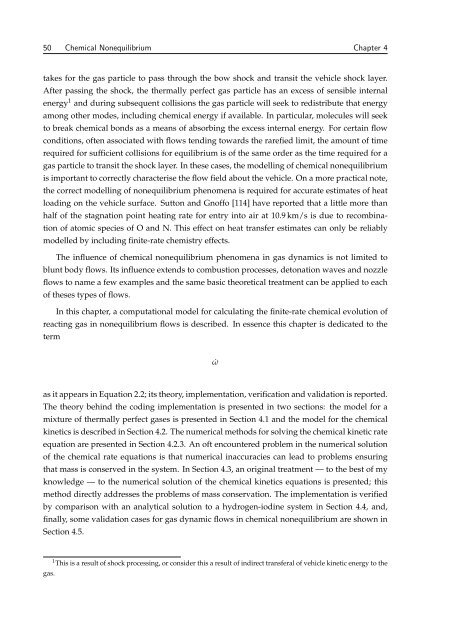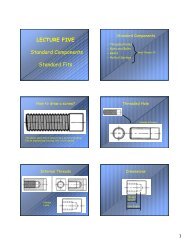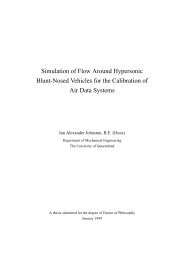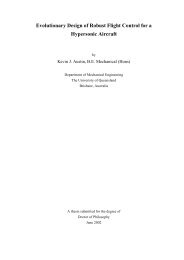Rowan-Gollan-PhD-Thesis - Mechanical Engineering - University of ...
Rowan-Gollan-PhD-Thesis - Mechanical Engineering - University of ...
Rowan-Gollan-PhD-Thesis - Mechanical Engineering - University of ...
You also want an ePaper? Increase the reach of your titles
YUMPU automatically turns print PDFs into web optimized ePapers that Google loves.
50 Chemical Nonequilibrium Chapter 4<br />
takes for the gas particle to pass through the bow shock and transit the vehicle shock layer.<br />
After passing the shock, the thermally perfect gas particle has an excess <strong>of</strong> sensible internal<br />
energy 1 and during subsequent collisions the gas particle will seek to redistribute that energy<br />
among other modes, including chemical energy if available. In particular, molecules will seek<br />
to break chemical bonds as a means <strong>of</strong> absorbing the excess internal energy. For certain flow<br />
conditions, <strong>of</strong>ten associated with flows tending towards the rarefied limit, the amount <strong>of</strong> time<br />
required for sufficient collisions for equilibrium is <strong>of</strong> the same order as the time required for a<br />
gas particle to transit the shock layer. In these cases, the modelling <strong>of</strong> chemical nonequilibrium<br />
is important to correctly characterise the flow field about the vehicle. On a more practical note,<br />
the correct modelling <strong>of</strong> nonequilibrium phenomena is required for accurate estimates <strong>of</strong> heat<br />
loading on the vehicle surface. Sutton and Gn<strong>of</strong>fo [114] have reported that a little more than<br />
half <strong>of</strong> the stagnation point heating rate for entry into air at 10.9 km/s is due to recombina-<br />
tion <strong>of</strong> atomic species <strong>of</strong> O and N. This effect on heat transfer estimates can only be reliably<br />
modelled by including finite-rate chemistry effects.<br />
The influence <strong>of</strong> chemical nonequilibrium phenomena in gas dynamics is not limited to<br />
blunt body flows. Its influence extends to combustion processes, detonation waves and nozzle<br />
flows to name a few examples and the same basic theoretical treatment can be applied to each<br />
<strong>of</strong> theses types <strong>of</strong> flows.<br />
In this chapter, a computational model for calculating the finite-rate chemical evolution <strong>of</strong><br />
reacting gas in nonequilibrium flows is described. In essence this chapter is dedicated to the<br />
term<br />
˙ω<br />
as it appears in Equation 2.2; its theory, implementation, verification and validation is reported.<br />
The theory behind the coding implementation is presented in two sections: the model for a<br />
mixture <strong>of</strong> thermally perfect gases is presented in Section 4.1 and the model for the chemical<br />
kinetics is described in Section 4.2. The numerical methods for solving the chemical kinetic rate<br />
equation are presented in Section 4.2.3. An <strong>of</strong>t encountered problem in the numerical solution<br />
<strong>of</strong> the chemical rate equations is that numerical inaccuracies can lead to problems ensuring<br />
that mass is conserved in the system. In Section 4.3, an original treatment — to the best <strong>of</strong> my<br />
knowledge — to the numerical solution <strong>of</strong> the chemical kinetics equations is presented; this<br />
method directly addresses the problems <strong>of</strong> mass conservation. The implementation is verified<br />
by comparison with an analytical solution to a hydrogen-iodine system in Section 4.4, and,<br />
finally, some validation cases for gas dynamic flows in chemical nonequilibrium are shown in<br />
Section 4.5.<br />
gas.<br />
1 This is a result <strong>of</strong> shock processing, or consider this a result <strong>of</strong> indirect transferal <strong>of</strong> vehicle kinetic energy to the







